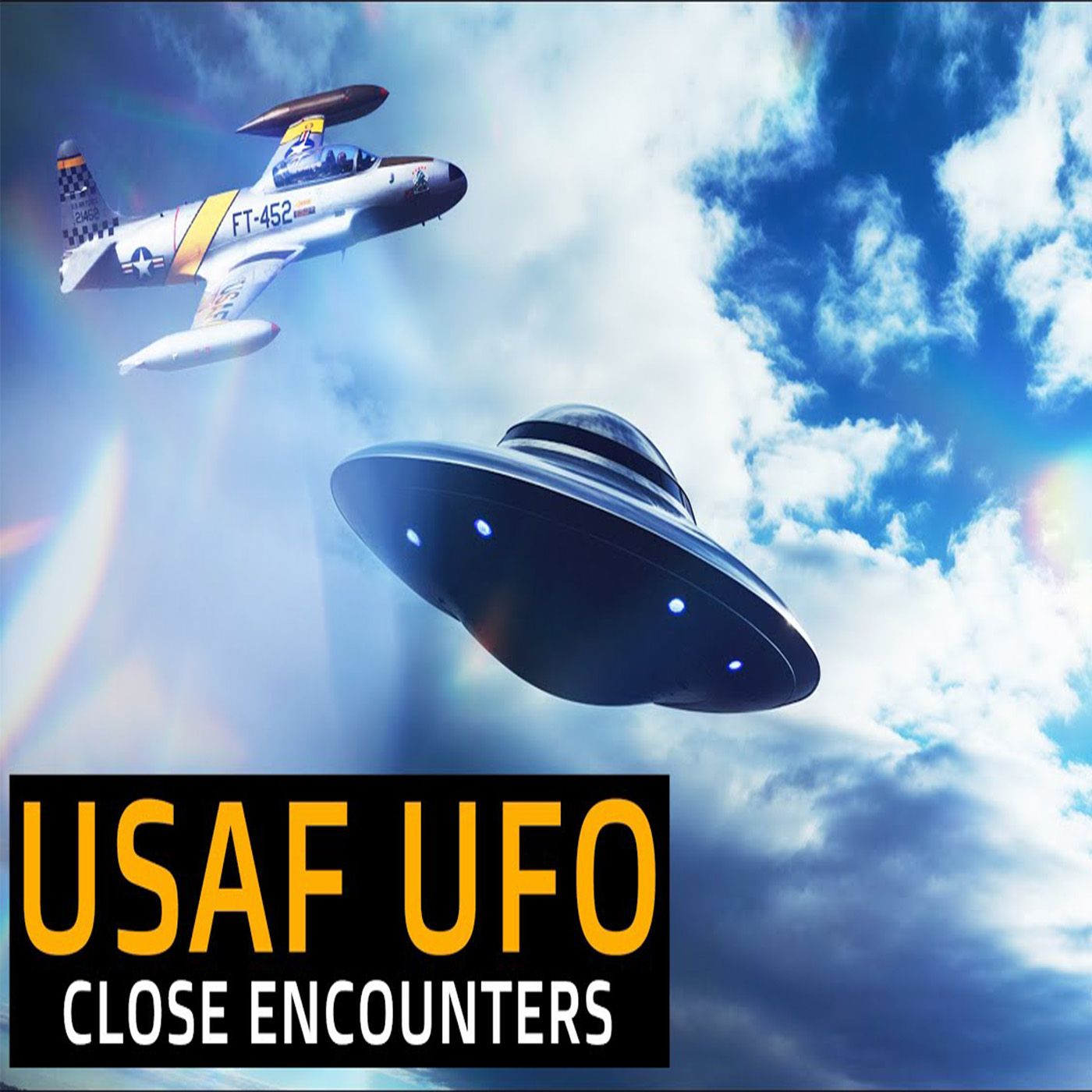Show Notes
There are just a handful of UFO close encounter cases that have occurred over the decades that changed the narrative, and even policy where the US Air Force is concerned, and this is one of them. Admissions had to be made, and even investigative projects get needed upgrades. This US Air Force UFO Close Encounter Changed Everything. Landmark cases often get swept under the rug, forgotten with time, but only by looking into the past can we get an understanding of some of the things that are happening now. These UFO briefs are your quick dosage of UFO news and case studies.If you enjoy the show, please leave a 5 star review..!!
To see the VIDEO of this episode, click or copy link - http://youtu.be/3ObIzIv42S0
❤️ EXCLUSIVE FREE MERCH INCLUDED & BEHIND-THE-SCENES ONLY FOR MY SUPPORTERS ON PATREON ➔ https://www.patreon.com/paradigm_shifts/membership
Visit my website with Articles, Videos, and Podcast direct links - https://strangeparadigms.com
Become a supporter of this podcast: https://www.spreaker.com/podcast/strange-and-unexplained--5235662/support.
Show Transcript
This is the UFO case that changed everything, shifting narratives from dismissive to more productive. At least, so they say. In UFO history, only a few cases have profoundly impacted military protocols and discourse such as the Fort Monument, the UFO incident in 1951. This case, investigated by the controversial Project Grudge would ultimately help reshape how the US Air Force approached the UFO phenomenon, leading to significant changes in investigation procedures and institutional attitudes, (00:53) changing it from Project Grudge to Project Blue Book. But first, we need to understand Project Grudge before we get into the case that, quote, changed everything. Project Grudge operating from right Patterson Air Force Base Air Technical Intelligence Center under Lieutenant Colonel Jerry Boggs initially took a skeptical approach to UFO investigations, examining 1,000 to 2,000 reports between 1947 and 1951, and typically dismissing them as misidentified aircraft, weather phenomena, weather balloons, or hoaxes. However, the Project underwent a significant transformation in 1951, (01:35) when Captain Edward Roupeld took over as director, implementing a more objective and systematic investigation methodology that included creating an unknown category for all of these unexplained cases and even dismissing 3 team members who showed a strong bias in either direction. This shift in approach was largely driven by a high profile case like the Fort Monmouth incident, which provided compelling evidence from credible military witnesses along with growing pressure from both military leadership and the public for more serious scientific investigation. While the Air Force maintained (02:16) that their primary interest was identifying potential threats to national security, nothing's changed in the last 80 years. The persistence of unexplained reports from credible observers ultimately led to Project Grudge's evolution into the more comprehensive Project Blue Book, and under Roupeld's leadership, the investigation maintained strict standards of objectivity in his own book, the report of unidentified flying objects published in 1956. (02:51) He notably dismissed three assistants who showed too much bias in their investigative approach, demonstrating his commitment to impartial analysis, either those that believed too much in UFOs or those that attempted to dismiss everything regardless of the data. The subsequent Pentagon meeting attended by representatives from public aircraft corporation and various military officials proved so sensitive that its recorded proceedings were later destroyed. Okay, now that we know about Grudge, let's get into the case. (03:27) On the morning of September 10th, 1951 at 11.18 am, the Fort Monmouth incident began when Army signal core students radar operator Eugene Clark detected an anomalous object on his radar monitor. By coincidence, several military officials were standing right behind the operator when this incident occurred. (03:50) The unidentified target moved with such extraordinary velocity estimated at approximately 700 miles per hour that the radar's automatic setting mode couldn't maintain tracking. The object eventually vanished from radar near Sandy Hook close to New York City, and then 17 minutes later at 11.35. The incident escalated dramatically when Lieutenant Wilbert Rogers and major Edward Baller Jr. (04:21) encountered the object while piloting their T-33 jets at 20,000 feet above point Pleasant, New Jersey. Rogers first spotted a Del Silvery object about 12,000 feet below him, traveling southward from Sandy Hook. Though originally on approach to the Mitchell Air Force base, Rogers altered course, so Major Baller could observe the object. (04:52) As it banked, the craft revealed a distant disc like silhouette prompting Rogers to execute a challenging 360 degree descending maneuver, dropping 3,000 feet to maintain visual contact. Both pilots estimated the craft was 30 to 50 feet in diameter and initially traveling at about 700 miles per hour. They quickly ruled out the balloon explanation as the object demonstrated controlled banking maneuvers and accelerated beyond their jet speed of 550 miles per hour. (05:31) After completing a 90 degree turn, the craft headed out over the ocean at near sonic speeds at around 5,000 feet altitude. During the brief radio exchange between Baller and Ground Control captured by an open microphone, the object made a descending arc-like turn beneath their flight path. Despite Rogers' attempt to pursue at 17,000 feet, the craft now exceeding 900 miles per hour disappeared over the ocean, having traveled 35 miles in just 2 minutes. (06:02) So what did he think about this? According to Niacap, Rogers and experienced World War 2 fighter pilot was later asked by a reporter what he thought he saw that day. He just shrugged and said that the object was something that he had never seen before in his life and it certainly wasn't a balloon because it was not only descending but moving at great speed. (06:27) He added that the object looked perfectly round and flat with the center of the object being somewhat raised. The days events were far from over at 3.15 pm. They received another urgent call directing radar operators to search for a target in the same area where the morning's object had managed. (06:48) This time, the object was traveling at a much slower pace at 93,000 feet. Several officers were able to visually confirm the object's presence as a "silver speck" in the afternoon sky. The following day brought two additional radar sightings with objects displaying unusual flight characteristics including rapid climbs, level-offs, and even dramatic dives. (07:16) And then two days later on September 12, a three-foot teletype message arrived at the Wright Patterson Air Force Base with a copy sent to Washington, DC. Major General Charles Cabell, director of the Air Force Intelligence, immediately contacted Colonel Frank Dunn at the Air Technical Intelligence Center demanding an immediate investigation at Fort Monmouth. (07:44) Lieutenant Jerry Cummings, the then head of Project Grudge, dispatched to New Jersey and their subsequent briefing to Cabell, encoded an intriguing attendee. A representative from the Republic Aircraft Corporation, who, according to Roupelts account, represented a group of prominent U.S. industrialists and scientists seeking more credible explanations from the Air Force regarding UFOs. (08:12) The presence of this representative attending at a General Officer's personal request suggested the possible existence of a higher-level oversight group, potentially similar to what would later be referred to as MJ12. But MJ12 is a whole other episode, and there's actually a two-part series you can find that link in the description box below if you want more details on MJ12. And then, according to Roupelts' book, he mentioned, "Every word of the two-hour meaning was recorded on a wire recorder. The recording was so hot, according to Roupelts, that it was later destroyed. (08:51) But not before he heard it several times." He says, quote, "I can't tell everything that was said, but to be conservative, it didn't exactly follow the tone of the official Air Force releases." With that being said, the Fort Monmouth UFO incident created a significant controversy between official explanations and eyewitness accounts. (09:19) While the Air Force attributed the sightings to weather balloons, sighting launch records from the period, this explanation faced strong opposition from multiple credible witnesses. The T-33 pilots adamantly maintained they had encountered a disc-shaped craft under intelligent control, exhibiting flight characteristics that were impossible for a balloon. (09:44) Their account was further supported by radar technicians at Fort Monmouth, who had verified there were no inversion layers present that could have caused atmospheric interference, which, according to Roupelts' book, all the witnesses were heavily interrogated. So if he thought Project Blue Book was dismissive, Project Rudge was even more so. And yet it only gets more interesting. (10:09) In Heinrich's book, the UFO experience, he stated that according to Captain Edward Roupelts, the shift in the Air Force's UFO investigation approach from Project Signed Project Rudge marked that he called the "dark ages" of UFO research. While Project Sign had maintained some openness to unexplained possibilities, Grudge's new personnel adopted a dismissive stance, summed by the theorem, "it can't be, therefore it isn't. (10:41) " Roupel noted that this change was driven by military leadership's preference for definitive answers over mysteries. A quick confidential dismissal, like it was a weather balloon, earned praise from the ATIC up to the Pentagon, whereas the previous approach of acknowledging uncertainty was seen as unsatisfactory. Despite continuing to receive approximately 10 significant UFO reports monthly, the Project largely abandoned serious investigations and verification efforts with more reports being summarily discarded under this new, more skeptical band-aid. Project Blue Book, while still maintaining a skeptical stance, (11:21) marked a significant departure from Project Grudge when using the unknown category when researching UFOs. While it was introduced by Project Grudge, it was hardly ever used. J. Allen Heineck, when he was operating Project Blue Book, used it a little bit more significantly. The key distinction finally allowed investigators to acknowledge cases that defied conventional explanation rather than forcing every sighting into a predetermined explanation as Project Grudge and Project Sight had done in the past. The aftermath of the Fort Monmouth incident proved (12:02) transformative, prompting General Cabell to order a complete reorganization of the Air Force's UFO investigation program. Under Edward Roopell's new leadership, Project Blue Book would emerge with a mandate for more objective analysis, effectively ending the dismissive era, a Project Grudge, an ushering, in-a-more systematic approach to researching UFOs. (12:27) What do you think about this? Do you see a difference between Project Grudge and Project Blue Book? Do you think that this case, the Fort Monmouth UFO incident that took place in 1951, was so significant that it altered the whole research process when looking at UFOs? If you enjoyed the show, hit that like button right down below and subscribe if you haven't already, as I do several shows right here every single week. (12:55) I do also write articles for all those shows and you can find that on my website at strangeparadimes.com, but also my social media links are in the description box below. That is it for today. I will see you next time. Be safe and remember, keep your eyes on the skies. If you enjoy the strange and the mysterious UFOs, the paranormal and creptids, this channel is for you. (13:36) So make sure to subscribe as I do three videos right here every single week and hit that notification bell so you do not miss any of the bonus content I post right here
.png)


Comments & Upvotes